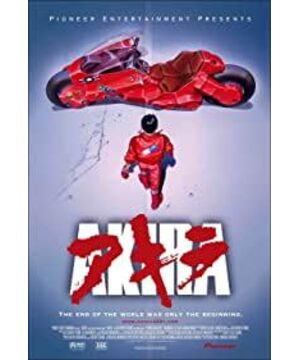Two good news first.
The 4K remastered version of Akira will be released exclusively on video platform ACFUN on June 22.
After missing the re-screening version, domestic audiences finally have the opportunity to re-experience the charm of this masterpiece.
Director Otomo Keyang will also produce a new adaptation of TV animation based on the original manga.
Although too much information has not been disclosed yet, since the original author is in charge, it must be an original work.
There will be re-screening first, then new works. If you are an "Akira fan", you can celebrate the New Year in advance.
But then again. Today, the reason why we are full of admiration for this work is not only because the movie accurately made the " God prophecy " about the Tokyo Olympics.
More, or out of the affirmation of its intrinsic value.
*In the film, not only does it appear that Japan will host the Olympic Games in 2020, but it even successfully predicts that the Tokyo Olympics will be suspended due to force majeure.
For a long time, "Aguila" has been regarded as "the originator of Japanese cyberpunk" and has unparalleled influence in the entire pan-cultural circle.
Whether it is "The Matrix", "Inception", or "Ready Player One" and "Stranger Things", many classic masterpieces across the era have paid tribute to "Aguilar" in different ways.
Interestingly, unlike the era when "Aguila" was released, based on the development of the times and the edification of a large number of film and television works, cyberpunk culture has gradually broken through the original audience circle.
In other words, more and more mainstream audiences are becoming fans.
Just to name a few examples.
For example, the live-action "Ghost in the Shell" starring Widow Sister , as well as "Alita" and "Blade Runner 2049" . In addition, there are American TV series "Copy", "Love, Death and Robots" produced by Netflix, etc.
In addition to film and television works, games are also a very important "cultural promoter".
In 2018, the latest trailer for "Cyberpunk 2077" developed by CD Projekt Red was released.
In the end, the game not only successfully came out of the circle with the well-made and stunning trailer, but also set off a wave of fan creations.
At the moment when this "cyberpunk craze" is sweeping the world, starting from "Aguilar", there are still many questions worthy of our consideration——
What exactly is cyberpunk, and what makes it so fascinating?
As the "three heroes of Japanese animation directors", how does Otomo Keyang express his humanistic concern in the film?
Why do some people call "Aguilar" a "different kind of cyberpunk", and what are the similarities and differences between it and other cyberpunk movies?
To find out, take this "Renaissance" journey together.
01. Visual Art in Cyberpunk
Indecision, quantum mechanics. Style jump, virtual world.
Can't explain it, travel through time and space. Don't understand color matching, cyberpunk.
Not enough brain holes, parallel universe. Not clear, tribute to Cthulhu.
I don't know since when, such a set of "creation formulas" became popular on the Internet.
While stepping on the "vital point", it also shows that many literary and artistic works are falling into the shackles of "self-replication".
Just like when you mention science fiction works, people will definitely think of robots, artificial intelligence, time travel, parallel time and space and other elements.
When it comes to cyberpunk, we subconsciously think of pictures with high saturation and red, blue, and purple as the keynote .
And all of this has to start from the "source of all evil " of "Blade Runner" .
As a pioneer in the absolute sense, while laying the foundation for the successors, the film also left a stereotype——
Rainy nights, neon, tall buildings, holographic projections, electronic signs, flying cars, and various symbols of oriental culture.
Even if you think the connotation of the story is too obscure and the threshold for appreciation is too high, you will definitely remember these elements of strong presence.
So, are these iconic symbols purely in the service of visuals? In all honesty, almost every symbol has a purpose.
Compared with natural light sources, artificial lights (neon lights) full of industrial style will appear more cold and dazzling.
In addition, the lighting is dominated by cool colors, making it more and more temperatureless.
When the characters travel through it, the audience will unconsciously be substituted into this materialistic society that lacks human touch.
The towering skyscrapers and the low and dilapidated slums form a sharp contrast, and the sense of oppression brought about by the height difference of the buildings highlights the disparity between the rich and the poor.
The more noisy and prosperous the city in the distance, the more it reflects the gloom and despair in people's hearts.
The ubiquitous billboards and holographic projections imply that consumerism is invading people's lives.
Whether you like it or not, you have to accept the baptism of advertising.
Such a dense bombardment of information also forms a subtle reflection with our current society.
Do not believe? Now open Weibo and Moments, and you will find that "tailor-made" advertisements have been placed in all the information streams.
The question is, why set the story stage on a rainy night?
Could it be that it is just to make the protagonist look handsome or forcibly improve his style?
No, no, a "cold knowledge" must be added here -
Blade Runner is also known as a " post-classic sci-fi noir ".
It symbolizes the rainy night of sin, the dark and distinct light and shadow, the low-angle lighting, and the depressing atmosphere.
These audio-visual languages belonging to noir films can be found in "Blade Runner" one by one.
There are both decadent and gloomy narrative atmosphere in the film noir style, as well as the superposition of many images.
And this is the charm of cyberpunk aesthetics.
02. The philosophical core of dystopia
Cool neon lights, huge advertisements, dense high-rise buildings, fast passing spaceships.
If a certain work has only learned to stack without brains, it can only be regarded as a "visual spectacle award" or a "cyberpunk style guide" at best.
There is a layer of skin in the air, obviously unable to touch the core of the problem.
High tech, Low-life, high tech, low life.
Stripping away all the abstract philosophical words and visual symbols, this is the most concise summary of the core of cyberpunk.
Just reading comprehension and generalizing the topic, it's not that hard. The real difficulty lies in how to present this core in the film, and make it understandable to the audience without being too straightforward.
for example.
In "Alita", two diametrically opposed cities, "Salem City" and "Scrap Iron City", are constructed.
The former symbolizes hope and light, and is the legendary Utopia on Earth.
The latter symbolizes evil and chaos, and is dubbed the "junkyard" by the male protagonist.
Although the inhabitants here enjoy superb technology and advanced means of transportation, mechanized people and robots can be seen everywhere.
But they still live in a squalid, poor and rundown environment that, at first glance, looks like a slum.
And, at any time, they could be killed and robbed horribly.
And there are only two meanings of their existence, either, to provide resources and labor for the city of Salem.
Or, try to win the mobile iron ball game, and then travel to Salem to change his personal destiny.
Similarly, "Aguilar" also fully expresses the essence of "high-tech, low-life".
In 1988, Tokyo was destroyed in the flames of World War III.
In 2019, after 31 years of reconstruction and expansion, "New Tokyo" has become a behemoth.
With advanced technology and high-rise buildings, people are immersed in extremely rich material civilization. However, this is only the surface.
Violence grows, chaos grows, order is out of balance, and conflicts between the ruled and those in power are imminent.
This is the "dark side of the moon" in this bustling city.
Just one detail.
At the beginning of the story, idols, boxing matches, mobsters, and people who took to the streets to protest the tax reform system appeared on the TV in the bar one after another.
These fleeting images can be simply and rudely condensed into a few symbols: entertainment, violence, class antagonism.
On one side is the "God-making Movement" of commercial culture, and on the other side are the people who want to resist injustice with violence.
Through the lens of just a few seconds, "Aguilar" shows us such a strange, divided and magical social landscape.
What is even more desperate is that this unspeakable division has permeated all of Tokyo.
For example, in the corners that the neon lights can't take care of, there is a group of beasts headed by Jintian .
They roam the dirty streets, bars and back alleys full of gray transactions, skipping school, racing cars, and making troubles are their daily routines.
Why do you have to choose this group of beasts as an entry point?
On the surface, hackers, marginalized groups, and low-level characters have always been the first choice for cyberpunk stories.
But in "Aguilar", the protagonist's setting actually has another meaning.
Looking back at the opening of the film, the dazzling white light, the silently annihilated buildings, and the huge potholes left on the surface suggest that Tokyo in 1982 experienced a nuclear explosion.
Throughout human history, Japan is the only country that has ever faced the lethality of nuclear weapons.
The tragedy is long gone, but the tragic memory left behind has become a national traumatic experience, and many movies focusing on "post-traumatic sequelae" have been derived from this.
In the same way, Otomo Keyang also expressed his humanistic concern and national complex in a subtle way.
Yes, the origin of the tyrannical tribe is closely related to the Hiroshima nuclear crisis - the earliest group of tyrannical tribes in Japan are the Hiroshima veterans.
Unable to escape the shadow of war, they shaved their heads, put on their uniforms, and stepped onto the locomotive, forming a raging grey wave.
The best part is that Otomo Keyang has also organically combined the "national trauma" symbolized by the beasts with the "bottom loss" under the cyberpunk worldview.
In the film, the living environment of old Tokyo has been revealed many times.
Contrary to imagination, the students in old Tokyo lived a very decadent campus life. Everyone either skipped class, or lay down bored and slapped on their own.
In short, no one takes learning seriously at all.
Of course, Jin Tian and others are no exception. As the old fritters among the delinquent teenagers, they were even threatened by the dean of education and the principal that if they couldn't keep up with their studies, they would be doomed.
"The world is rebuilding, external political pressures are heavy, an uncertain future is weighing on everyone's head, and a bunch of self-deceiving kids are killing their boring lives with drag racing."
As Otomo Keyang said, these beasts in "Aguilar" deeply reflect the confusion and restlessness of the bottom-level characters.
Living on the edge of the city, their studies are abandoned, and their future is bleak. All they can do is to use the roar of the locomotive engine to vent their inner roar and roar.
"The future is here, it's just not evenly distributed."
As William Gibson said, what cyberpunk works try to present is such a dystopian world full of chaos and injustice.
03. A fable across time and space
Visual art, humanistic care, depicting the social scene, and the characteristics of cyberpunk have been described in detail in the previous article.
But talking about it, it always feels like it's almost meaningless.
So, let's start with the source--
Cyberpunk is actually a compound word, consisting of "Cybernetics" and "Punk", also known as digital punk, computer traitor, etc.
Among them, the former extends the concept of "cyborg", which refers to the fusion of human flesh and machinery, which is the so-called "mechanical enhancement" and " prosthetic transformation ".
In all kinds of science fiction works, it is usually shown as a robot or a biochemical transformation.
From this point of view, "Aguila", which has no intubation behind the head, no mechanical modification, and no cyberspace at all, is indeed a "wonderful flower".
You may be curious, how did it become the originator of Japanese cyberpunk?
After all, it's not "cyber" at all. Don't worry, let's take a look first.
For a long time, cyberpunk literature has its own philosophical background, and the propositions involved are also quite extensive and profound:
Individual and totalitarian, self and id, free will, class antagonism, gap between rich and poor.
Falling into the movies, too.
From the philosophical level, we will deeply explore the ego, id, and superego, and think about the ultimate topic of "what is human?" This is "Ghost in the Shell";
Exploring the boundary between human nature and self, this is "Blade Runner";
Discussing the philosophical propositions of reality and fantasy, this is The Matrix.
As pioneers of the cyberpunk genre, these works seem to shine in different philosophical fields.
But in fact, different paths lead to the same goal— they remain a concern for human values and ideas.
Therefore, external elements such as "cyborg" and "human-machine interface" are never the only criteria for judging works.
The question is, how does Akira embody the humanistic connotation?
Speaking of which, we have to mention the creative background of the film.
In the 1980s, when Japan's economy was at its peak, GDP soared rapidly, and the economy, culture, and consumption levels were thriving and flourishing everywhere.
"Sell Tokyo, you can buy the entire United States", a similar saying is widely circulated among the people. Overnight, all the Japanese people swelled up, immersed in the dream of a drunken fan.
However, Otomo Keyang prefers to be the "disappointing person", because he vaguely captures a sense of danger from behind the bustling scene.
This sense of crisis is undoubtedly revealed in the film.
What exactly is "Aguilar"?
There have always been various interpretations of this.
Some say it refers to Akira, the mysterious boy in the movie.
Others believe that it is an allusion to the atomic bomb named "Little Boy" in history.
The cultists in the movie think Akira is their "Lord of Light".
But it is certain that "Aguilar" is indeed a power that is difficult for humans to control——
Because of the power out of control, Tetsuo first devoured his girlfriend Junko, and then destroyed Tokyo in the war;
Addicted to human experiments, the doctor who watched Tie Xiong out of control also suffered the consequences;
Dissecting Akira, the bureaucratic organization trying to control superpowers for his own use, even pushed Tokyo to hell twice.
If "Aguila" refers to nuclear weapons, doesn't the "Two Destruction of Tokyo" prove that humanity will eventually bring its own annihilation?
Is "technology" a hope that leads mankind to the light, or a "Pandora's Box" that will bring destruction?
In the end, is it technology or humans that are causing the loss of control?
For this series of questions, the film does not give exact answers.
The director chose to use the mouths of the characters to criticize the abuse of "absolute power" by human beings:
"If the order is disrupted because of some mistake, the amoeba has the power of humans, they will not build houses and bridges, but will only devour the food around them."
"This kind of energy, we still can't..."
"One day, we too can...".
With this narration, the movie came to an abrupt end.
Although critical, Akira also retains a more optimistic side.
Humans are indeed good at "destruction", but at the same time they have "creativity" that amoeba can't match, isn't it? From a macro perspective, destruction and rebirth are the cycle of human history.
The footage of Jintian and others heading into the distance also indicates that a new era will eventually come.
I'm afraid Otomo Keyang himself can't imagine that the collapsed Tokyo in the story and the forced suspension of the Olympic Games have encountered similar crises in reality.
Past and future, fantasy and reality, two-dimensional and three-dimensional.
Through "Aguila", Otomo Keyang realized a dialogue that spanned time and space and the dimensional wall, which can even be called a "fable".
Perhaps, this is the value of divine work.
View more about Akira reviews











